1) Which of the following professionals is most likely to generate the income of a superstar?
a. the best teacher
b. the best dentist
c. the best author
d. the best airplane pilot
Answer: View Answer
2) A consumer is currently spending all of her available income on two goods: music CDs and DVDs. At her current consumption bundle, she is spending twice as much on CDs as she is on DVDs. If the consumer has $120 of income and is consuming 10 CDs and 2 DVDs, what is the price of a DVD?
a. $4
b. $8
c. $12
d. $20
Answer: View Answer
3) Which of the following is not correct?
a. Critics argue that minimum-wage laws hurt the very people they are intended to help.
b. Minimum-wage laws may increase unemployment among the groups of workers affected by the minimum wage.
c. If the demand for unskilled labor is relatively inelastic, the higher wage will produce more unemployment than if the demand for unskilled labor is relatively elastic.
d. Minimum-wage laws may benefit teenagers from middle-class families, so the policy is not a precise way to help the poor.
Answer: View Answer
4) The theory of efficiency wages asserts that
a. unions are often successful in forcing employers to pay higher wages.
b. employers strive to hold wages below equilibrium levels.
c. employers may find it profitable to pay above-equilibrium wages.
d. efficient workers actually earn lower wages than those earned by inefficient workers.
Answer: View Answer
5) The following diagram shows a budget constraint for a particular consumer.
If the price of X is $5, what is the price of Y?
a. $2
b. $10
c. $30
d. $300
Answer: View Answer
6) 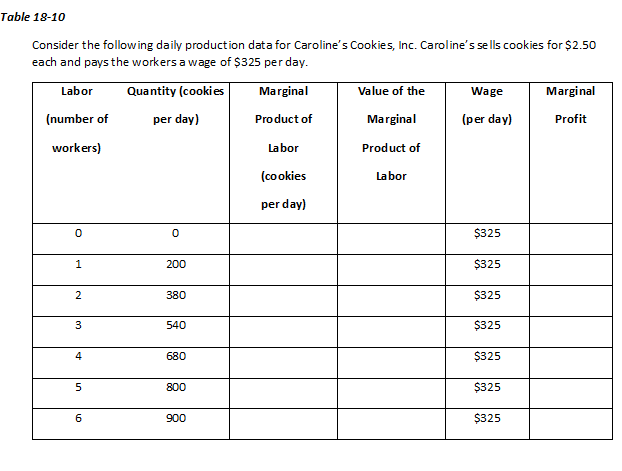
Refer to Table 18-10. The marginal product of labor begins to diminish with the addition of which worker?
a. the 1st worker
b. the 2nd worker
c. the 3rd worker
d. the 4th worker
Answer: View Answer
7) 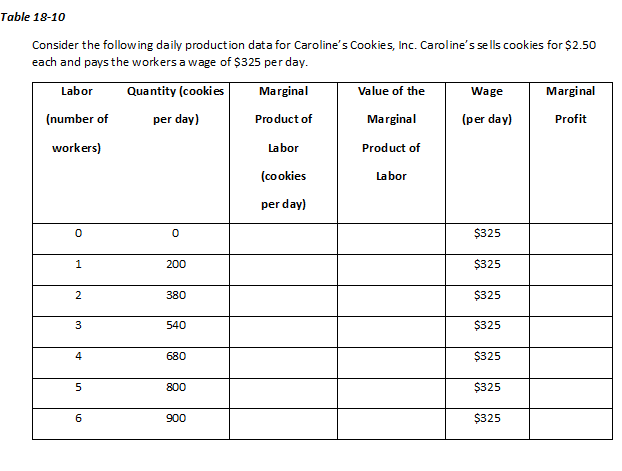
Refer to Table 18-10. Assume that Carolines Cookies is a competitive, profit-maximizing firm. If the market price of cookies decreases from $2.50 to $2.00, how many workers would the firm then hire?
a. 2 workers
b. 3 workers
c. 4 workers
d. 5 workers
Answer: View Answer
8) In the prisoners dilemma game with Bonnie and Clyde as the players, the likely outcome is
a. a very good outcome for both players.
b. a very good outcome for Bonnie, but a bad outcome for Clyde.
c. a very good outcome for Clyde, but a bad outcome for Bonnie.
d. a bad outcome for both players.
Answer: View Answer
9) Which of the following is an example of a firms derived demand?
a. The wage that a worker earns is a function of her human capital.
b. A firms demand for college textbook study guide authors is inseparably linked to the supply of college textbooks.
c. Factors that increase the demand for labor will increase the equilibrium wage.
d. All of the above are correct.
Answer: View Answer
10) What percent of families are poor for eight or more years?
a. more than 20 percent
b. between 15 and 20 prcent
c. approximately 10 percent
d. less than 3 percent
Answer: View Answer
11) 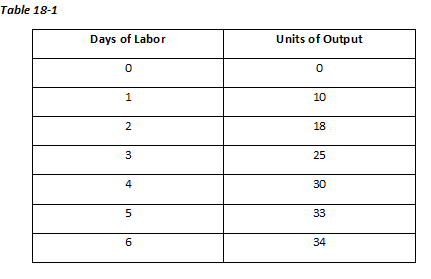
Refer to Table 18-1. Suppose that the firm pays its workers $50 per day. Each unit of output sells for $20. How many days of labor should the firm hire?
a. 3
b. 4
c. 5
d. 6
Answer: View Answer
12) Scenario 18-4
In 1997, Albania experienced a civil war. The civil unrest sent thousands of refugees across the Adriatic Sea to Italy where they sought relief from the fighting.
Refer to Scenario 18-4. The Albanian civil war probably affected Italian labor markets by causing
a. total employment in Italy to decrease.
b. wages in Italy to increase.
c. the marginal product of labor in Italy to decrease.
d. All of the above are correct.
Answer: View Answer
13) Firms do not need to be concerned about striking a balance between the price effect and the output effect when making production decisions in which of the following types of markets?
a. oligopoly
b. duopoly
c. monopoly
d. competitive markets
Answer: View Answer
14) Which of the following is an example of customer discrimination?
a. European soccer players earn more than U.S. soccer players since soccer is more popular in Europe.
b. Male basketball players in the NBA earn higher salaries than female basketball players in the WNBA since viewers prefer watching NBA games.
c. Golfers on the mens PGA tour earn more than golfers on the womens LPGA tour since people prefer watching the men play golf.
d. All of the above are examples of customer discrimination.
Answer: View Answer
15) In the short run, a firm in a monopolistically competitive market operates much like a
a. firm in a perfectly competitive market.
b. firm in an oligopoly.
c. monopolist.
d. monopsonist.
Answer: View Answer
16) Scenario 15-2
Consider a local, privately-owned electrical cooperative named Minny County Megawatts (MCM, LLC). MCM has just completed a natural-gas-burning electrical power plant in the Midwest. Currently, MCM can meet the electricity needs of all residents in the county. In fact, its capacity far exceeds the needs of the county. After just a few years of operation, the shareholders of MCM experienced incredible rates of return on their investment due to the profitability of the corporation.
Refer to Scenario 15-2. Which of the following statements is most likely to be true?
(i) New entrants to the market know they will have a smaller market share than MCM currently has.
(ii) MCM would experience higher profits if it were government-run.
(iii) MCM is a natural monopoly.
a. (i) and (ii) only
b. (ii) and (iii) only
c. (i) and (iii) only
d. (i), (ii), and (iii)
Answer: View Answer
17) Your friend works at a coffee shop on campus and regularly gives away free coffee to you and your friends when you visit. In this example, your friend is the
a. principal and the owner of the coffee shop is the agent.
b. agent and the owner of the coffee shop is the principal.
c. signaler and the owner of the coffee shop is the screener.
d. screener and the owner of the coffee ship is the signaler.
Answer: View Answer
18) Scenario 19-5
Billy works for the local piano moving company part-time after school. Billy has worked for the company for two years but still hasn’t received a wage increase, even though newer employees have received raises. Billy has threatened his employer with a lawsuit if he doesn’t get a raise in the next few weeks. Billy believes he is a victim of labor-market discrimination.
Refer to Scenario 19-5. In a competitive market for piano movers, why might Billy’s wage differential persist?
a. Billy works harder than the other employees.
b. Billy joins a labor union.
c. Billy’s amiable personality allows him to work well with his co-workers.
d. Customers do not like Billy because he has a bad attitude.
Answer: View Answer
19) 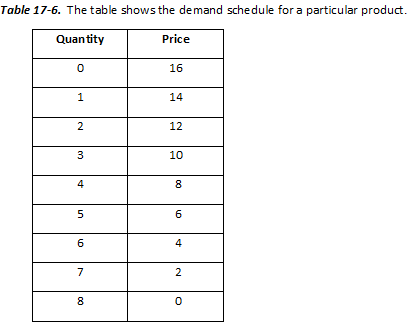
Refer to Table 17-6. Suppose the market for this product is served by two firms that have formed a cartel. If the marginal cost of production is $4 and the fixed cost is $6, the combined profit of the cartel will be
a. $6
b. $12
c. $24
d. $32
Answer: View Answer
20) Assume that a consumers indifference curve is a downward-sloping straight line. As the consumer moves from left to right along the horizontal axis, the consumers marginal rate of substitution
a. increases.
b. decreases.
c. remains constant.
d. increases, then decreases.
Answer: View Answer
21) Empirical work that does not account for differences in the productivity of workers
a. is unlikely to find evidence of wage differentials.
b. can provide strong evidence of labor market discrimination.
c. is likely to misinterpret apparent evidence of labor market discrimination.
d. is accepted as superior to empirical work that does correct for differences in productivity of workers.
Answer: View Answer
22) Defenders of advertising argue that it is not rational for profit-maximizing firms to spend money on advertising for products that have
a. superior quality.
b. inferior or mediocre quality.
c. low prices.
d. limited availability.
Answer: View Answer
23) Scenario 15-7
Black Box Cable TV is able to purchase an exclusive right to sell a premium movie channel (PMC) in its market area. Let’s assume that Black Box Cable pays $150,000 a year for the exclusive marketing rights to PMC. Since Black Box has already installed cable to all of the homes in its market area, the marginal cost of delivering PMC to subscribers is zero. The manager of Black Box needs to know what price to charge for the PMC service to maximize her profit. Before setting price, she hires an economist to estimate demand for the PMC service. The economist discovers that there are two types of subscribers who value premium movie channels. First are the 4,000 die-hard TV viewers who will pay as much as $150 a year for the new PMC premium channel. Second, the PMC channel will appeal to 20,000 occasional TV viewers who will pay as much as $20 a year for a subscription to PMC.
Refer to Scenario 15-7. What is the deadweight loss associated with the nondiscriminating pricing policy compared to the price discriminating policy?
a. $375,000
b. $400,000
c. $475,000
d. It cannot be determined from the information provided.
Answer: View Answer
24) The fundamental cause of monopoly is
a. incompetent management in competitive firms.
b. the zero-profit feature of long-run equilibrium in competitive markets.
c. advertising.
d. barriers to entry.
Answer: View Answer
25) 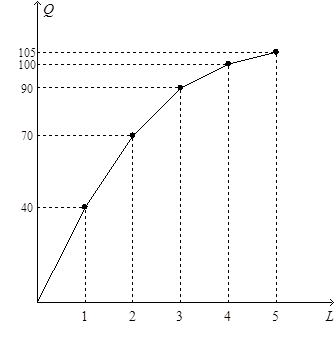
Refer to Figure 18-2. Suppose the firm pays a wage equal to $160 per unit of labor and sells its output at $10 per unit. How many units of labor should the firm hire to maximize profit?
a. 2 units
b. 3 units
c. 4 units
d. 5 units
Answer: View Answer
26) Liberalism suggests that public policies should aim to
a. maximize the sum of utility of everyone in society.
b. maximize the well-being of the average person in society.
c. maximize the well-being of the worst-off person in society.
d. minimize the difference between the utility of the best-off person in the society and the utility of the worst-off person in society.
Answer: View Answer
27) The market for wheat is most likely considered a monopolistically competitive market.
Answer: View Answer
28) All points on a demand curve are optimal consumption points.
Answer: View Answer
29) The science of economics is a finished jewel, perfect and unchanging.
Answer: View Answer
30) An increase in the wages paid to high-school student who detassle corn will increase the labor supply of high-school students who weed soybean fields, all else equal.
Answer: View Answer
31) Labor-saving technological advances increase the marginal productivity of labor.
Answer: View Answer
32) The theory of consumer choice illustrates that people face tradeoffs, which is one of the Ten Principles of Economics.
Answer: View Answer
33) A firm in a monopolistically competitive market is usually indifferent to an additional customer walking through the door, since a sale to that customer will not increase the firm’s profit.
Answer: View Answer
34) From 1959 to 2009, inflation-adjusted wages increased by 131 percent in the U.S. As a result, firms reduced the amount of labor they employed by nearly 20 percent.
Answer: View Answer
35) Susie wins $2 million in her states lottery. If Susie keeps working after she wins the money, we can infer that the income effect is larger than the substitution effect for her.
Answer: View Answer